| comments | difficulty | edit_url | rating | source | tags | |||||
|---|---|---|---|---|---|---|---|---|---|---|
true |
Medium |
1707 |
Biweekly Contest 123 Q2 |
|
You are given a 2D array points of size n x 2 representing integer coordinates of some points on a 2D plane, where points[i] = [xi, yi].
Count the number of pairs of points (A, B), where
Ais on the upper left side ofB, and- there are no other points in the rectangle (or line) they make (including the border).
Return the count.
Example 1:
Input: points = [[1,1],[2,2],[3,3]]
Output: 0
Explanation:
There is no way to choose A and B so A is on the upper left side of B.
Example 2:
Input: points = [[6,2],[4,4],[2,6]]
Output: 2
Explanation:
- The left one is the pair
(points[1], points[0]), wherepoints[1]is on the upper left side ofpoints[0]and the rectangle is empty. - The middle one is the pair
(points[2], points[1]), same as the left one it is a valid pair. - The right one is the pair
(points[2], points[0]), wherepoints[2]is on the upper left side ofpoints[0], butpoints[1]is inside the rectangle so it's not a valid pair.
Example 3:
Input: points = [[3,1],[1,3],[1,1]]
Output: 2
Explanation:
- The left one is the pair
(points[2], points[0]), wherepoints[2]is on the upper left side ofpoints[0]and there are no other points on the line they form. Note that it is a valid state when the two points form a line. - The middle one is the pair
(points[1], points[2]), it is a valid pair same as the left one. - The right one is the pair
(points[1], points[0]), it is not a valid pair aspoints[2]is on the border of the rectangle.
Constraints:
2 <= n <= 50points[i].length == 20 <= points[i][0], points[i][1] <= 50- All
points[i]are distinct.
First, we sort the array. Then, we can classify the results based on the properties of a triangle.
- If the sum of the two smaller numbers is less than or equal to the largest number, it cannot form a triangle. Return "Invalid".
- If the three numbers are equal, it is an equilateral triangle. Return "Equilateral".
- If two numbers are equal, it is an isosceles triangle. Return "Isosceles".
- If none of the above conditions are met, it is a scalene triangle. Return "Scalene".
The time complexity is
class Solution:
def numberOfPairs(self, points: List[List[int]]) -> int:
points.sort(key=lambda x: (x[0], -x[1]))
ans = 0
for i, (_, y1) in enumerate(points):
max_y = -inf
for _, y2 in points[i + 1 :]:
if max_y < y2 <= y1:
max_y = y2
ans += 1
return ansclass Solution {
public int numberOfPairs(int[][] points) {
Arrays.sort(points, (a, b) -> a[0] == b[0] ? b[1] - a[1] : a[0] - b[0]);
int ans = 0;
int n = points.length;
final int inf = 1 << 30;
for (int i = 0; i < n; ++i) {
int y1 = points[i][1];
int maxY = -inf;
for (int j = i + 1; j < n; ++j) {
int y2 = points[j][1];
if (maxY < y2 && y2 <= y1) {
maxY = y2;
++ans;
}
}
}
return ans;
}
}class Solution {
public:
int numberOfPairs(vector<vector<int>>& points) {
sort(points.begin(), points.end(), [](const vector<int>& a, const vector<int>& b) {
return a[0] < b[0] || (a[0] == b[0] && b[1] < a[1]);
});
int n = points.size();
int ans = 0;
for (int i = 0; i < n; ++i) {
int y1 = points[i][1];
int maxY = INT_MIN;
for (int j = i + 1; j < n; ++j) {
int y2 = points[j][1];
if (maxY < y2 && y2 <= y1) {
maxY = y2;
++ans;
}
}
}
return ans;
}
};func numberOfPairs(points [][]int) (ans int) {
sort.Slice(points, func(i, j int) bool {
return points[i][0] < points[j][0] || points[i][0] == points[j][0] && points[j][1] < points[i][1]
})
for i, p1 := range points {
y1 := p1[1]
maxY := math.MinInt32
for _, p2 := range points[i+1:] {
y2 := p2[1]
if maxY < y2 && y2 <= y1 {
maxY = y2
ans++
}
}
}
return
}function numberOfPairs(points: number[][]): number {
points.sort((a, b) => (a[0] === b[0] ? b[1] - a[1] : a[0] - b[0]));
const n = points.length;
let ans = 0;
for (let i = 0; i < n; ++i) {
const [_, y1] = points[i];
let maxY = -Infinity;
for (let j = i + 1; j < n; ++j) {
const [_, y2] = points[j];
if (maxY < y2 && y2 <= y1) {
maxY = y2;
++ans;
}
}
}
return ans;
}public class Solution {
public int NumberOfPairs(int[][] points) {
Array.Sort(points, (a, b) => a[0] == b[0] ? b[1] - a[1] : a[0] - b[0]);
int ans = 0;
int n = points.Length;
int inf = 1 << 30;
for (int i = 0; i < n; ++i) {
int y1 = points[i][1];
int maxY = -inf;
for (int j = i + 1; j < n; ++j) {
int y2 = points[j][1];
if (maxY < y2 && y2 <= y1) {
maxY = y2;
++ans;
}
}
}
return ans;
}
}

